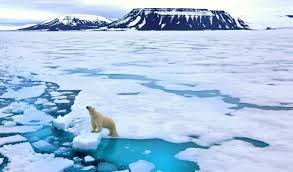The Arctic has long been the traditional homeland of Indigenous Peoples, with vibrant communities that have thrived for thousands of years. For these communities, climate change is not a future concern but a present-day reality, driving numerous environmental, economic, and social shifts.
Sea ice serves as a vital infrastructure, enabling travel to neighboring communities and harvest locations while being integral to cultural practices. However, as the Arctic warms, unpredictable weather patterns are disrupting sea ice conditions.
The shortening ice road season and longer periods without ice are making travel more hazardous, especially for those in remote areas. These changes threaten the safety, culture, and livelihoods of Indigenous communities, significantly impacting their way of life.
Read More: Arctic Connections: The Growing Threat to Indigenous Communities in the Arctic
A Changing Marine Environment
For millennia, Indigenous Peoples in the Arctic have relied on hunting for sustenance, clothing, and cultural practices. Hunting remains a vital part of their identity, especially as store-bought food is costly and often less nutritious than traditional sources.
However, shifts in sea ice, precipitation, and temperatures are disrupting the availability of key species. As the ice retreats, non-Arctic predators, such as killer whales, are expanding their range and targeting Arctic species like beluga and bowhead whales, walruses, and seals.
This alteration in ecosystems makes traditional hunting increasingly difficult for Indigenous communities.The growth of industries such as mining and oil extraction further exacerbates the situation, placing additional strain on the Arctic environment.
New infrastructure, including railways, and rising shipping traffic contribute to increased black carbon emissions, which harm local health, leading to higher rates of heart and lung disease.
Additionally, oil spills, wastewater discharge, ship strikes, and underwater noise pollution pose significant threats to both Arctic wildlife and ecosystems.
An Uncertain Future for Reindeer in the Arctic
Reindeer herding has long been a cornerstone of traditional life for many Indigenous Peoples across the Arctic. Today, around 100,000 active herders continue this practice in Norway, Sweden, Finland, and Russia. However, this way of life is increasingly threatened by environmental changes.
Rising temperatures are leading to more frequent winter rain events, which create layers of ice on snow. Normally, reindeer rely on their keen sense of smell to locate lichen, their primary food source, under the snow.
The ice, however, blocks their ability to access this vital nourishment, forcing them to spread out over larger areas in search of food.Compounding this challenge, the vast, open lands needed for reindeer to thrive are steadily disappearing.
Industrial activities such as mining, the construction of new transportation routes, and other developments are encroaching on the Arctic landscape, disrupting migration routes and eliminating pastures. As a result, reindeer husbandry is becoming increasingly difficult in many parts of the region.
Indigenous Peoples as Equal Partners for Action
The Arctic is experiencing increasing political and economic interest, primarily from external sources, leading to a surge in industrial activity. Coupled with rapid warming, this is severely impacting the lives and livelihoods of Arctic communities.
Without swift, decisive action to reduce greenhouse gas emissions and halt the decline in biodiversity, traditional ways of life, as well as vital species and ecosystems, risk disappearing forever.Immediate action at all levels of government and society is essential to limit global warming to 1.5 degrees Celsius.
Any rise above this threshold will drastically alter the Arctic, endangering the health, livelihoods, and cultural identities of Indigenous and local communities.Arctic nations must recognize Indigenous Peoples as equal partners in the stewardship of the region and the management of its resources.
The integration of scientific research with Indigenous Knowledge is crucial for enabling the Arctic to adapt to climate change and the mounting pressures from industrial expansion.
Increased investment and stronger commitments are urgently needed—unfortunately, the pledges made at COP27 fall short of what is required.
Frequently Asked Questions (FAQs)
How does climate change affect Arctic Indigenous communities?
Climate change disrupts traditional activities like hunting and herding, threatening the health, livelihoods, and cultures of Arctic Indigenous Peoples.
Why is sea ice important?
Sea ice enables travel and access to hunting areas. Its loss disrupts these activities, risking food security and safety.
How does industrial activity impact Indigenous Peoples?
Industries like mining and oil extraction cause habitat destruction, pollution, and disrupt migration patterns, threatening ecosystems and local livelihoods.
What role do Indigenous Peoples play in resource management?
Indigenous communities have vital traditional knowledge that is essential for sustainable management of Arctic resources and preserving ecosystems.
What can be done to protect the Arctic?
Governments need to reduce emissions, protect biodiversity, and involve Indigenous Peoples in decision-making to ensure sustainable development.
How does the loss of reindeer pastures affect Indigenous Peoples?
The loss of pastureland due to climate change and industrial activity threatens reindeer herding, impacting food security and cultural practices.
Conclusion
The Arctic is undergoing rapid changes that threaten not only its unique ecosystems but also the way of life for Indigenous Peoples who have inhabited the region for thousands of years. The impacts of climate change, coupled with industrial development, pose significant risks to both the environment and local communities. For these challenges to be effectively addressed, it is crucial to recognize the invaluable role of Indigenous knowledge in managing Arctic resources and ecosystems.

